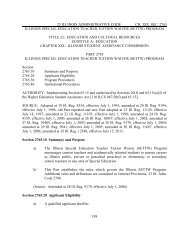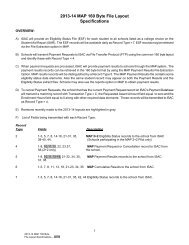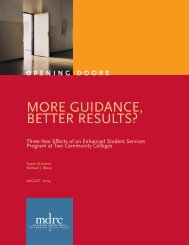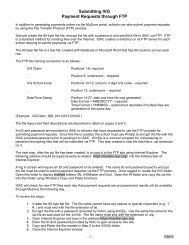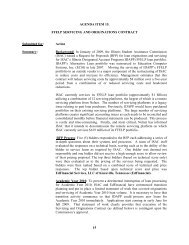High school rigor and good advice: Setting up students to succeed
High school rigor and good advice: Setting up students to succeed
High school rigor and good advice: Setting up students to succeed
Create successful ePaper yourself
Turn your PDF publications into a flip-book with our unique Google optimized e-Paper software.
Two-year institution: If they <strong>to</strong>ok Pre-Calculus or Calculus beyond Algebra II, a student in the high<br />
SES/achievement gro<strong>up</strong> is about 18 percent more likely <strong>to</strong> persist compared <strong>to</strong> the low SES/achievement<br />
gro<strong>up</strong> which is 27 percent more likely <strong>to</strong> persist. In two-year institutions, 33 percent of <strong>students</strong> enter<br />
with Algebra I, Geometry, or less as their highest level of high <strong>school</strong> math. Only around half of these<br />
<strong>students</strong> persist <strong>to</strong> their second year, <strong>and</strong> these <strong>students</strong> represent almost half of all non-persisting<br />
<strong>students</strong> in two-year institutions. What is also striking is a student in the low SES/achievement gro<strong>up</strong><br />
who takes one math course higher than Algebra II, has a better chance of persisting than a high or<br />
middle SES/achievement student with only Algebra I. Low SES/achievement <strong>students</strong> can increase their<br />
chances of persisting by 44 percent by taking Pre-Calculus or Calculus instead of only Algebra I or<br />
Geometry.<br />
Math test scores<br />
Four-year institutions: Math skills appear <strong>to</strong> be a very important predic<strong>to</strong>r of persistence in four-year<br />
institutions. Looking at math scores from college entrance exams such as SAT/ACT 8 shows persistence<br />
rates are higher as you get higher scores. There are not an adequate amount of <strong>students</strong> with high<br />
ACT/SAT math scores for college-goers in two-year institutions for analysis (about 5 percent), so we only<br />
looked at four-year institutions. If we just look at the ACT Math scores (or equivalent SAT Math scores)<br />
of all college-going <strong>students</strong>, there is a dramatic effect from achieving a high score 9 . When comparing<br />
<strong>students</strong> with similar SES <strong>and</strong> prior achievement at four-year institutions, the increased chances from<br />
scoring high instead of low on the College-going ACT/SAT Math scores are as follows:<br />
<strong>High</strong> SES/Achievement Gro<strong>up</strong>: Scoring a 28 rather than an 18 on the ACT (or equivalent SAT Math<br />
score) increases your chances of persisting by 9 percent.<br />
Middle SES/Achievement Gro<strong>up</strong>: Scoring a 28 rather than an 18 on the ACT (or equivalent SAT Math<br />
score) increases your chances of persisting by 12 percent.<br />
Low SES/Achievement Gro<strong>up</strong>: Scoring a 28 rather than an 18 on the ACT (or equivalent SAT Math<br />
score) increases your chances of persisting by 15 percent.<br />
7



